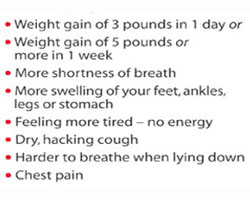Symptoms of Heart Failure

The symptoms caused by the heart failure are usually divided into left and right-sided. Moreover, if the heart failure is left-sided, after some time, the right side of the heart will also become involved in the pathological process (the most common cause of right-sided heart failure is left-sided heart failure).
Left-sided Heart Failure
When the left side of the heart begins to fail, the blood accumulates in the lung vasculature which increases the hydrostatic pressure inside the blood vessels. The increase in hydrostatic pressure causes the liquid part of the blood to enter the alveoli which leads to respiratory failure since this impairs the gas exchange within the lungs. This leads to:
- Increase of the heart rate and the rate of breathing in order to compensate for the poor gas exchange.
- If the body is unable to compensate for poor gas exchange it causes:
o Hypoxemia – drop in oxygenation of the blood. This causes the person to feel faint and may lead to syncope.
o Hypercapnia – rise of CO2 in the arterial blood. Hypercapnia causes faster breathing (since the breathing center reacts to the concentration of carbon dioxide and not oxygen), flushed skin, arrhythmia (extrasystoles), muscle twitches, and reduced neural activity.
- Non-productive cough – the accumulation of liquid in the alveoli triggers a non-productive cough. In some cases, if the cough is severe, it can lead to hemoptysis (coughing up blood), since when coughing, small blood vessels can get ruptured. This symptom is often referred to as “cardiac asthma”.
- Orthopnea or paroxysmal nocturnal dyspnea – shortness of breath when lying flat. This is why the person can only breathe freely when he or she is standing or reclining. The reason why a person starts suffocating when lying down is that when lying flat, the blood spreads evenly throughout the body. This can overload the pulmonary circulation if the function of the left side of the heart is impaired.
- Fatigue – due to poor oxygenation of the blood the person’s tolerance for exercise is substantially reduced. Fatigue is also caused by poor blood flow inside skeletal muscles.
- Poor systemic circulation – since the ability of the left side of the heart to push the blood through systemic circulation is impaired, the person may also have the following symptoms:
o Dizziness and confusion – since the blood flow in the brain is reduced
o Cool extremities at rest – similarly, the reduced blood flow in the extremities causes them to become cooler than normal.
o Anemia – poor blood circulation in kidneys reduces their ability to produce erythropoietin, which is responsible for triggering the production of erythrocytes.
Right-sided Heart Failure
Poor function of the right side of the heart causes congestion (accumulation of blood) of systemic capillaries. This primarily affects the legs since gravity pulls the blood down into them when the person is sitting or standing up. One of the most noticeable symptoms of right-sided heart failure is swelling of ankles and feet (this symptom is known as peripheral edema). As the disease progresses, the swelling can move higher up the legs. Other symptoms include:
- Ascites – increasing hydrostatic pressure within systemic capillaries causes the liquid part of the blood to leave the vessels. Ascites is the accumulation of liquid in the abdominal cavity.
- Congestive hepatomegaly – right sided heart failure results in rising blood pressure in inferior vena cava and veins that bring the blood to it, including hepatic veins (veins that drain blood from the liver). If the venous blood pressure is too high, the liver becomes congested (engorged) with blood which can lead to serious malfunctions. Over time, congestive hepatomegaly leads to congestive cirrhosis (scaring of the liver tissues) which, in turn, leads to liver failure. In severe cases, the patient may develop jaundice and even problems with blood clotting (coagulopathy).
- Nocturia – frequent urination during the night. This symptom appears as a result of peripheral edema. The liquid that accumulates in the body (mainly in the lower extremities due to gravity) during the day is able to leave the body when the person is lying flat and the liquid returns to the bloodstream.
Biventricular Heart Failure
In the majority of cases, left-sided heart failure eventually leads to right-sided heart failure due to an increased blood pressure in pulmonary circulation. This leads to biventricular heart failure which has the symptoms of both left and right-sided heart failure.
Next Chapter: Diagnosis of Heart failure









